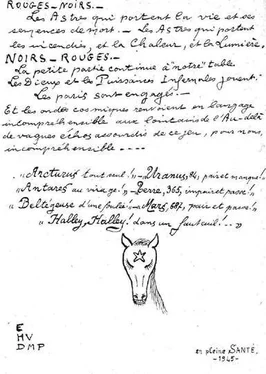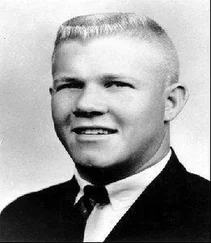Did Petiot have a last confession or any final words? “No,” he said. “I am a traveler who is taking all his baggage with him.”
After the nape of his neck was shaved, Desfourneaux tied Petiot’s arms behind his back at the wrist and elbow. His shirt collar was ripped. “A pity,” Petiot said. “So beautiful a shirt, which cost my wife so much. Think, it was a Christmas gift.” According to Obrecht, present as the assistant executioner, Petiot then joked of a sudden crisis of uremia and asked to urinate.
“For the first time in my life,” Dr. Paul noted, “I saw a man leaving death row, if not dancing, at least showing perfect calm. Most people about to be executed do their best to be courageous, but one senses that it is a stiff and forced courage. Petiot moved with ease, as though he were walking into his office for a routine appointment.”
Outside, in the prison courtyard in the early-morning gray, Petiot smiled at the executioner and turned to the delegation that waited nearby. “Gentlemen, I have one last piece of advice. Look away. This will not be pretty to see.”
His feet were tied together and he was strapped to the wooden tilting table and lowered into place with his neck in the lunette. A lever was released. At five minutes after five, the head rolled into the wicker basket with a thump.
37.
THE LOOT
THE SECRET OF ALL GREAT FORTUNES … IS ALWAYS SOME FORGOTTEN CRIME—FORGOTTEN, MIND YOU, BECAUSE IT’S BEEN PROPERLY HANDLED.
—Honoré de Balzac, Père Goriot
JO the Boxer’s gold watch, Joachim Guschinow’s fur coats, Lulu’s emerald ring—the profits of the false escape agency can only be imagined. How much gold, silver, currency, how many diamonds, emeralds, signet rings, bonds, and other valuables were sewn into clothes, hidden in shoes, and packed into suitcases with dreams of a new life abroad? Add to this figure the fees Petiot collected for promising to supply forged papers and arrange the passage over rugged mountains, across a frontier, and then onto an ocean liner bound for Argentina.
Sometimes, too, the client had handed over property. Ilse Gang testified how Petiot carted away the Wolff furniture; Christiane Roart described the many attempts to gain possession of the Kneller property; and Raymond Vallée noted the strange messages, purportedly from Dr. Braunberger, asking him to transfer his furniture. Petiot also probably earned a percentage of the profits when he referred his clients to secondhand dealers, as both Joseph Scarella and René Marie experienced. As for the suits, shirts, shoes, dresses, coats, and wide variety of personal belongings in the suitcases found in Neuhausen’s attic, how long was it before they ended up on the black market or sold to a German purchasing agency?
Without knowing the true number of victims or what each person carried to rue Le Sueur, there is no meaningful estimate of Petiot’s profits. Indeed, no one has ever established the total number of victims, which could be anything from a handful to 26 (the court’s opinion), 63 (Petiot’s claim), 150 (Dr. Paul’s off-the-record estimate), or perhaps even more (Director of the Police Judiciaire René Desvaux’s guess). Clearly, however, the profits were substantial. The fifty-odd suitcases that had lined the back wall of the courtroom represented only a fraction of the lucrative enterprise.
But where was this fortune now?
Some of Petiot’s wealth was clearly invested in property. Although rumors often exaggerated the number of buildings he owned, Petiot had snapped up several bargains as real estate prices plummeted during the Nazi Occupation. In addition to rue Le Sueur, he purchased buildings at 52 rue de Reuilly, as well as properties in nearby Auxerre, Villeneuve-sur-Yonne, and Seignelay. Some were purchased in his name, or that of his son, his brother, or his father-in-law. What about the rest of his treasure that he did not sink into real estate?
At one of the first interrogations, Petiot told Gollety that he kept the bulk of his fortune at rue Le Sueur. He never elaborated beyond that, and neither subsequent interrogations nor testimony at the trial had clarified the matter. In 1952, an architect bought the rue Le Sueur town house and proceeded to tear down the building “stone by stone.” The demolition and rebuilding were closely watched, but no treasure was uncovered there or, as far as anyone knows, in any of his other properties.
As the defendant refused to discuss the fate of his alleged riches, rumor naturally filled in the gap. Some people believed that he had buried the treasure. At one point, René Nézondet claimed that Petiot had instructed him upon his release at Fresnes to relay a message to Georgette: “Go where you know to go and dig where you know to dig.” This, however, was almost roundly dismissed. Some believed it was simply a joke on Petiot’s part. Others interpreted it as another manifestation of Nézondet’s tendency to exaggerate his own importance in the affair. At any rate, the likelihood of Petiot recruiting the talkative Nézondet for this special message was slim.
In 1968, the British writer Ronald Seth suggested that the fortune had been seized by the Communist Party. According to this theory, the Communists had protected Petiot during his flight from the police and therefore taken his wealth, securing his cooperation by threatening to harm his wife and son. Unfortunately, Seth did not cite any evidence. What he did not know, however, was that the man who had arrested Petiot, Captain Simonin, would later reveal that the suspect did in fact claim that the Communists had sheltered him. And from his own investigations, Simonin believed that this was probably correct. But that is a far cry from saying that the wealth ended up in Communist possession, and no evidence of that has ever emerged.
Indeed the climate in autumn of 1944—when Petiot presented himself to Communist leaders at the Reuilly armory—was dramatically different from the one that prevailed a few years before, when he was luring people to his town house on rue Le Sueur. Although the evidence is tenuous at best, there was probably a different protector at that time, and another possibility for where he hid his wealth.
IN early February 1944, two shiny black cars had pulled up in front of a small house in the town of Joigny, on the bank of the Yonne River. Among the arrivals was Marcel Petiot. He was accompanied by six men in flashy suits, flaunting gaudy rings on every finger. They had arrived for the funeral of the physician’s distant cousin, Céline Petiot, a reclusive widow who had died poor and without children.
That night, Petiot volunteered to keep watch at the vigil while the members of the deceased’s extended family got some much-needed rest. As the relatives went into the kitchen for a late snack, the physician entered the room where he would spend the night alone with the casket. He brought two large, bulging suitcases.
The next morning, when the pallbearers arrived, they discovered that the coffin, already nailed shut, was extraordinarily heavy. Immediately after the burial, Petiot and his entourage filed into their cars and sped away. The doctor’s suitcases, this time, appeared to be very light.
One of the men in the car with Petiot was very curious about what Petiot had buried in the grave of this relative. Several months later, in the autumn after the Liberation, he decided to take a look. Bringing along a friend, he returned to the grave site, removed the tombstone, and went to work with shovel and pickaxe. The two men opened the coffin. No treasure. Remarkably, however, there was no skeleton, either. There was nothing at all inside. Someone, they believed, had beaten them to the loot.
Whether Petiot actually hid his treasure, or more likely a part of it, in the grave of his relative is hard to say. But this small country funeral raises a number of questions. For one, only a couple of weeks earlier, Petiot had been released from Fresnes prison by the Gestapo. No one has ever adequately explained this release—arguments that the Gestapo would suddenly free him for only 100,000 francs or, as Jodkum said, by virtue of his insanity, strain credibility. The hypothesis that someone intervened on his behalf seems more plausible, but if so, then who was it, and more to the point, why did this protector allow Petiot to be arrested in the first place, let alone endure almost eight months of prison, including torture?
Читать дальше












